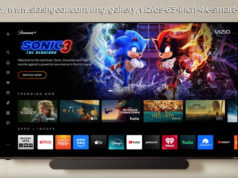Apple did not make the first personal computer, nor the first tablet computer, nor the first smartphone. Measuring it against what comes first is — to..
The perennial refrain of Android fans is that Apple is just adding stuff to iOS that they’ve had for years already in their mobile ecosystem. And it’s certainly true that Cupertino makes a point of waiting until it believes a technology is properly baked and the time is juuuuust right — or at least commercially judicious — to introduce a new product or capability, one which has likely already been in widespread use across the mobile platform aisle.
Hence the company is often charged with being an innovation laggard. While its senior execs are always fielding questions about why such and such a product or feature isn’t in Apple’s line-up yet.
The company’s strategy for, you could say, mis managing expectation has seen it frequently swing from publicly rubbishing a device type or technology — to warmly embracing it a few years later. (Or, well, not, in the case of Flash .)
Steve Jobs was master of this dark marketing art. You don’t usually see his more mild-mannered replacement, Tim Cook, deploying the kind of extended public trashtalking that Jobs indulged, raging out at this or that rival tech as ludicrous, impossible to use and horribly designed. Before performing a complete U-turn down the line.
Cook mostly limits himself to getting a bit fired up about Android security and fragmentation during keynotes. But the current Apple CEO has still presided over some major swerves in its position on tech developments — from finally inflating the screen size of the iPhone, in 2014, to adding and (now) extending support for NFC, as well as introducing wireless charging in its newest iPhone 8/8 Plus and iPhone X models.
He was also at the helm when Apple outed a stylus for its iPad Pro line — braving the inexorable flak given Jobs’ very public loathing for such sticks (among many jabs at styli, Jobs left us this choice quote: “If you need a stylus you’ve already failed”).
The lesson here is that Apple has always said — and will always say — whatever it needs to in public as it bides its time, continues its analysis and waits until its target mainstream market will appreciate the utility of what it’s developing. As Jobs also used to say, the things Apple chooses not to do are as important to what it does include in the products.
And of course it does not always get this balancing act right. It was, after all, rather slow to increase smartphone screen size and move into the phablet space. Yet at the same time lots of iPhone users clearly liked the four-inch handset form factor, hence Apple subsequently re-introducing it, with the iPhone SE.
A more major misjudgment came in 2013 when it tried to offer a plastic-backed iPhone, aka the iPhone 5c. The market responded with a resounding: no thanks! — and the model was quietly discontinued. (Perhaps because offering a cheaper build material went against Apple’s grain of expanding the pool of technological innovations it offers users.)
But any statements the company makes that appear intended to rubbish rival innovations should be read as a placeholder signal which states: yes Apple is interested, yes Apple is looking, yes Apple is probably testing and prototyping; but no Apple, is not yet ready to take the plunge.
Apple did not make the first personal computer, nor the first tablet computer, nor the first smartphone. Measuring it against what comes first is — to paraphrase Jobs — a boneheaded way of looking at the company. Rather its energy is spun up and spent on doing the hard assessment work of figuring out how to make key technology innovations accessible and usable across the broadest audience. From toddlers to senior citizens.
And the mass consumer adoption of these technologies is the real innovative heart of Apple.
So when this refining modus operandi means the company has to publicly change course and contradict something it’s said before, its execs don’t even feel the need to break a sweat. Because this is the reality of the task they’ve set themselves — to guide consumers one more rung up the tech ladder.
That’s the kind of engineering business Apple is in.
2013, Tim Cook: “Some people use OLED displays, but the colour saturation is awful. If you ever buy anything online and really want to know what he color is, as many people do, you should really think twice before you depend on the color from an OLED display.”
2017, Phil Schiller: “This is the first OLED display great enough to be in an iPhone.”
2012, Phil Schiller: “Having to create another device you have to plug into the wall is actually, for most situations, more complicated.”
2017, Phil Schiller: “Words can’t describe just how much nicer it is to just put it down and pick it up whenever you want to charge without every having to plug in a cable again.”
2013, Craig Federighi, touting Apple AirDrop as a better alternative to NFC: “No need to wander around the room, bumping your phone… [mimes bumping phones]”
September 2014, Eddie Cue: “We’ve got a groundbreaking NFC antenna built across the top… Apple Pay is easy and secure and it’s private.”
September 2014, Tim Cook, on Apple Pay: “It is so cool!”
2017: Apple (quietly) expands NFC support in iOS 11 beyond Apple Pay — to enable it to read NFC tags in the real world
2013, Tim Cook: “The iPhone 5 offers… a new four-inch retina display, which is the most advanced display in the industry. It also provides a larger screen size without sacrificing the one-handed ease of use that our customers love.”
2014, Tim Cook, introducing iPhone 6 and 6 Plus: “Today we are launching the biggest advancement in the history of iPhone.”
2014, Phil Schiller: “Yes, they’re bigger. They’re a lot bigger… Your photos look gorgeous and there’s more to see on each of them.
“And when you turn them in landscape we show more as well. And we took special advantage of the iPhone 6 Plus because of all those pixels to do some new things with our apps. So, for example, the messages app now has a new horizontal two-up display… We do everything to take advantage of these huge displays to make them more capable.”
2013, Tim Cook, asked about opening up iOS keyboard for third party apps: “I think you’ll see us open up more in future, but not to the degree that we’ll put the customer at risk of having a bad experience.”
2014, Craig Federighi, introducing the ability to install system-wide third party keyboards: “So now if you have a special keyboard you want to use you can install those on iOS, and by default those of course run inside of the most restricted sandbox with no network access, because we want to make sure to protect your privacy.






